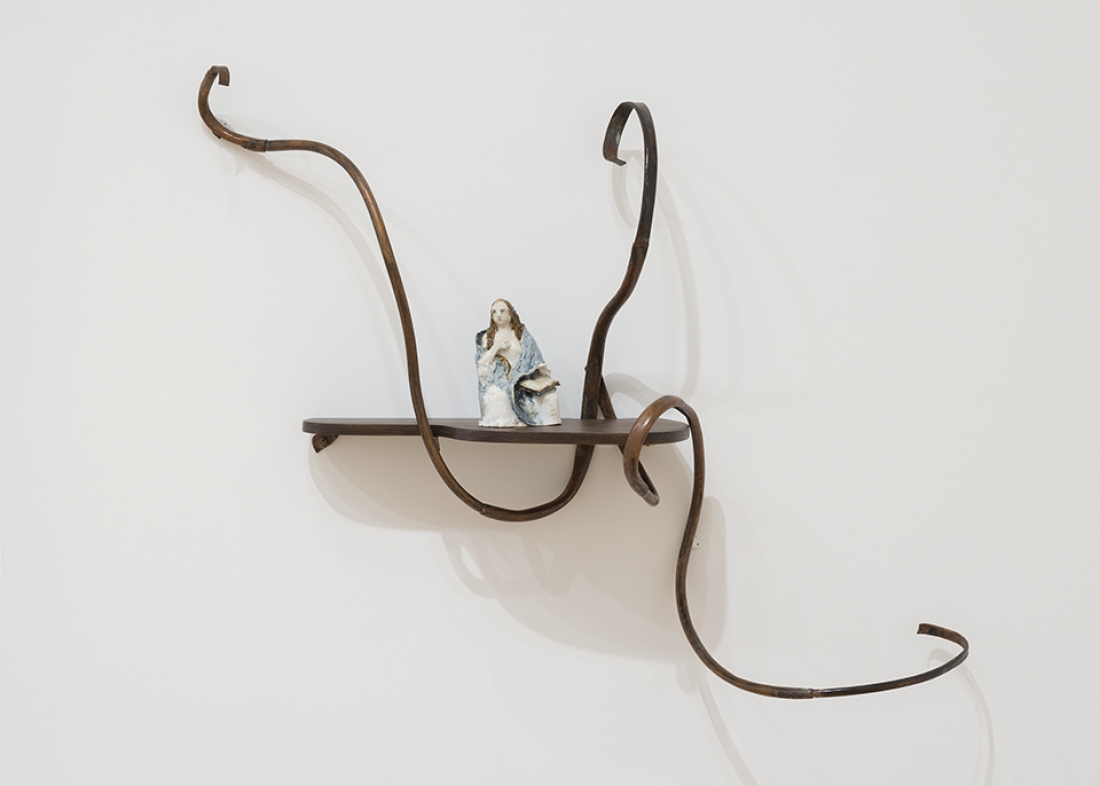Mary Carlson Garden
March 23 - April 27, 2024
installation images selected works thumbnails

Mary Magdalene (after El Greco), 2024, glazed porcelain, wood, copper
Inspired by El Greco’s Penitent Magdalene, Carlson explores Mary as penitent, but free of shame. In El Greco’s painting, her attire is pious, but revealing, and her upward gaze and posture seem repentant. Carlson evokes the same clothing and pose, but presents Mary as modest, yet quietly confident.
Press Release
Mary Carlson
“Garden”
March 23 - April 27, 2024
"Garden" marks Mary Carlson’s second solo exhibition with Kerry Schuss. Consisting of elemental materials, Carlson’s glazed porcelain saints rest upon on sinuous copper vines and hardwood shelves. Drawing upon visual motifs from medieval manuscripts and embroidered clerical vestments, the sculptures explore notions of penitence, prosperity, and paradise. Carlson’s version of Eden undulates on the gallery walls, creating an installation that could as easily be situated in a prior century as now.
For the first time, Carlson’s porcelain saints are freed from the constraints of pedestals, emerging within a burgeoning environment—the result of Carlson’s venture into new wood-and metal-working techniques. Cradling figures or blossoming into flora, the spiraling copper supports derive from artwork in the margins of illuminated manuscripts. Exquisitely crafted, the vines are comprised of separate copper pieces that fit into one another, mimicking the real texture of branches. This is the culmination of Carlson’s long-researched endeavor to create a holistic, living setting for her works to exist in— surpassing traditional methods of display.
During her research, Carlson encountered the 13th century French manuscript Le Roman de la Rose (The Romance of the Rose). A courtly love poem, the pages’ margins are filled with blossoming vines, whose flowers appear highly abstracted and generic, or as the artist notes, “more symbolic than specific.” Unknown to Carlson at the time she referenced the book's design, the poem uses the word “rose” as both the titular female character and as a metaphor for female sexuality. Drawing from one of the poem’s illuminated leaves, Four Blue Flowers (2024), a single tapering vine meticulously rendered in copper, grows upward from the gallery floor, blooming with porcelain flowers.
Carlson is consistently drawn to the invisible threshold of “pre” and “post” temptation, as tied to Eve’s “fall” and subsequent banishment from the garden Eden. In Dorothea (2023/2024), the patron saint of gardens and florists is abundant and flourishing, lavishly dressed. Carrying a bowl of fruit, she seems to be emerging from a paradisiacal realm. While St. Dorothea’s lifespan exists many years after Eve’s banishment, in Carlson’s depiction she exists without this inheritance, exuding dignity and self-assuredness.
Similarly, Carlson mixes and subverts notions of penitent versus prosperous figures. She depicts Mary of Egypt (2022/2024) clutching three loaves of bread, which she subsisted on during 40 years in the desert in hermetic isolation. A prostitute who embarked on a pilgrimage to Jerusalem from Alexandria to continue her trade, Mary received the Eucharist and retreated from society. During her time in solitude, her clothes rotted and her hair became her garment, often rendered in Medieval depictions as an animalistic coating of fur. Here, Carlson re-envisions them as radical blue locks.
The hardwood shelves and copper vines echo the same notions of prosperity and untamed qualities emphasized in the figures the artist depicts. Carlson approaches the striking new presence of metalwork as a means of making marginalia three dimensional and structural, and thereby more substantial. In her own words, “it’s about taking the curlicue seriously.”
—
Mary Carlson has been making her art for over 50 years. Using a wide range of mediums, materials and subject matter: making everything from hand-sewn American flags, a giant crocheted pink octopus, carved life-sized trees to 'altered' furniture. Her current medium of choice is hand-built porcelain, with glazes formulated and fired in her Walton, NY studio. She has created a ‘saints and demons’ series based on depictions of heaven and hell found in Medieval and Renaissance manuscripts and paintings.
A Guggenheim, Tiffany, NEA, and NYFA award-recipient, Carlson's work was first shown in New York at Leo Castelli Gallery in 1985. She has also shown in the 1995 Venice Biennale, Kunsthalle Wein; Kunstlerhaus Bethanien, Berlin; the New Museum; the Aldrich Museum and numerous galleries in New York and around the country. Most recently she was awarded a fellowship at Civitella Ranieri, Italy for September 2021.